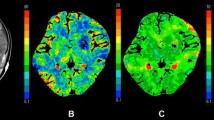Abstract
An uncontrolled increase in intracranial pressure (ICP), often due to cerebral edema, is the most common cause of death in patients with traumatic brain injury (TBI). Different types of edema coexist in TBI patients: Vasogenic edema and cytotoxic edema. Vasogenic edema occurs with the extravasation of fluid into the extracellular space following blood brain barrier (BBB) disruption. Cytotoxic edema results from a shift of water from the extracellular compartment into the intracellular compartment due, in part, to alterations in normal ionic gradients. Description of the localization and knowledge of the chronology, determinants, and kinetics of the BBB disruption are necessary to adapt therapeutic strategy.
Access this chapter
Tax calculation will be finalised at checkout
Purchases are for personal use only
Preview
Unable to display preview. Download preview PDF.
Similar content being viewed by others
References
Barzo P, Marmarou A, Fatouros P, Corwin F, Dunbar J (1996) Magnetic resonance imaging-monitored acute blood-brain barrier changes in experimental traumatic brain injury. J Neurosurg 85: 1113–1121
Baldwin SA, Fugaccia I, Brown DR, Brown LV, Scheff SW (1996) Blood-brain barrier breach following cortical contusion in the rat. J Neurosurg 85: 476–481
McLaughlin MR, Marion DW (1996) Cerebral blood flow and vasoresponsivity within and around cerebral contusions. J Neurosurg 85: 871–876
Daneyemez M (1999) Microangiographic changes following cerebral contusion in rats. Neuroscience 92: 783–790
Furuya Y, Hlatky R, Valadka AB, Diaz P, Robertson CS (2003) Comparison of cerebral blood flow in computed tomographic hypodense areas of the brain in head-injured patients. Neurosurgery 52: 340–345
Hoelper BM, Soldner F, Chone L, Wallenfang T (2000) Effect of intracerebral lesions detected in early MRI on outcome after acute brain injury. Acta Neurochir Suppl 76: 265–267.
von Oettingen G, Bergholt B, Gyldensted C, Astrup J (2002) Blood flow and ischemia within traumatic cerebral contusions. Neurosurgery 50: 781–788
Phelps ME, Gado MH, Hoffman EJ (1975) Correlation of effective atomic number and electron density with attenuation coefficients measured with polychromatic x rays. Radiology 117: 585–588
Mull RT (1984) Mass estimates by computed tomography: Physical density from CT numbers. Am J Radiol 143: 1101–1104
Puybasset L, Cluzel P, Gusman P, et al (2000) Regional distribution of gas and tissue in acute respiratory distress syndrome. I. Consequences for lung morphology. CT Scan ARDS Study Group. Intensive Care Med 26: 857–869
Rouby JJ, Puybasset L, Cluzel P, et al (2000) Regional distribution of gas and tissue in acute respiratory distress syndrome. II. Physiological correlations and definition of an ARDS Severity Score. CT Scan ARDS Study Group. Intensive Care Med 26: 1046–1056
Rouby JJ, Puybasset L, Nieszkowska A, Lu Q (2003) Acute respiratory distress syndrome: lessons from computed tomography of the whole lung. Crit Care Med 31 (Suppl): S285–295
Lescot T, Bonnet MP, Zouaoui A, et al (2005) A quantitative computed tomography assessment of brain weight, volume, and specific gravity in severe head trauma. Intensive Care Med 31: 1042–1050
Degos V, Lescot T, Zouaoui A, et al (2006) Computed tomography-estimated specific gravity of noncontused brain areas as a marker of severity in human traumatic brain injury. Anesth Analg 103: 1229–1236
Degos V, Pereira AR, Lescot T, et al (2008) Does brain swelling increase estimated specific gravity? Neurocrit Care 9: 338–343
Lescot T, Degos V, Zouaoui A, et al (2006) Opposed effects of hypertonic saline on contusions and noncontused brain tissue in patients with severe traumatic brain injury. Crit Care Med 34: 3029–3033
Gardenfors A, Nilsson F, Skagerberg G, Ungerstedt U, Nordstrom CH (2002) Cerebral physiological and biochemical changes during vasogenic brain oedema induced by intrathecal injection of bacteriallipopolysaccharides in piglets. Acta Neurochir (Wien) 144: 601–608
Talmor D, Roytblat L, Artru AA, et al (1998) Phenylephrine-induced hypertension does not improve outcome after closed head trauma in rats. Anesth Analg 87: 574–578
Bullock R, Smith R, Favier J, du Trevou M, Blake G (1985) Brain specific gravity and CT scan density measurements after human head injury. J Neurosurg 63: 64–68
Nath F, Galbraith S (1986) The effect of mannitol on cerebral white matter water content. J Neurosurg 65: 41–43
Kita H, Marmarou A (1994) The cause of acute brain swelling after the closed head injury in rats. Acta Neurochir Suppl (Wien) 60: 452–455
Marmarou A, Portella G, Barzo P, et al (2000) Distinguishing between cellular and vasogenic edema in head injured patients with focal lesions using magnetic resonance imaging. Acta Neurochir Suppl 76: 349–351
Blacque-Belair A, Mathieu de Fossey B, Fourestier M (1965) Dictionnaire des Constantes Bio logiques et Physiques, 4th edition. Maloine, Paris
Habgood MD, Bye N, Dziegielewska KM, et al (2007) Changes in blood-brain barrier permeability to large and small molecules following traumatic brain injury in mice. Eur J Neurosci 25: 231–238
Chen Y, Constantini S, Trembovler V, Weinstock M, Shohami E (1996) An experimental model of closed head injury in mice: pathophysiology, histopathology, and cognitive deficits. J Neurotrauma 13: 557–568
van den Brink WA, Santos BO, Marmarou A, Avezaat CJ (1994) Quantitative analysis of blood-brain barrier damage in two models of experimental head injury in the rat. Acta Neurochir Suppl (Wien) 60: 456–458
Tanno H, Nockels RP, Pitts LH, Noble LJ (1992) Breakdown of the blood-brain barrier after fluid percussive brain injury in the rat. Part 1: Distribution and time course of protein extravasation. J Neurotrauma 9: 21–32
Beaumont A, Marmarou A, Fatouros P, Corwin F (2002) Secondary insults worsen blood brain barrier dysfunction assessed by MRI in cerebral contusion. Acta Neurochir Suppl 81: 217–219
Author information
Authors and Affiliations
Editor information
Editors and Affiliations
Rights and permissions
Copyright information
© 2010 Springer Science + Business Media Inc.
About this paper
Cite this paper
Degos, V., Lescot, T., Puybasset, L. (2010). Quantitative CT Scan and CT-Estimated Brain Specific Gravity in TBI. In: Vincent, JL. (eds) Intensive Care Medicine. Springer, New York, NY. https://doi.org/10.1007/978-1-4419-5562-3_38
Download citation
DOI: https://doi.org/10.1007/978-1-4419-5562-3_38
Publisher Name: Springer, New York, NY
Print ISBN: 978-1-4419-5561-6
Online ISBN: 978-1-4419-5562-3
eBook Packages: MedicineMedicine (R0)




